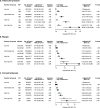Polygenic risk score-based phenome-wide association for glaucoma and its impact on disease susceptibility in two large biobanks
- PMID: 38622600
- PMCID: PMC11020996
- DOI: 10.1186/s12967-024-05152-4
Polygenic risk score-based phenome-wide association for glaucoma and its impact on disease susceptibility in two large biobanks
Abstract
Background: Glaucoma is a leading cause of worldwide irreversible blindness. Considerable uncertainty remains regarding the association between a variety of phenotypes and the genetic risk of glaucoma, as well as the impact they exert on the glaucoma development.
Methods: We investigated the associations of genetic liability for primary open angle glaucoma (POAG) with a wide range of potential risk factors and to assess its impact on the risk of incident glaucoma. The phenome-wide association study (PheWAS) approach was applied to determine the association of POAG polygenic risk score (PRS) with a wide range of phenotypes in 377, 852 participants from the UK Biobank study and 43,623 participants from the Penn Medicine Biobank study, all of European ancestry. Participants were stratified into four risk tiers: low, intermediate, high, and very high-risk. Cox proportional hazard models assessed the relationship of POAG PRS and ocular factors with new glaucoma events.
Results: In both discovery and replication set in the PheWAS, a higher genetic predisposition to POAG was specifically correlated with ocular disease phenotypes. The POAG PRS exhibited correlations with low corneal hysteresis, refractive error, and ocular hypertension, demonstrating a strong association with the onset of glaucoma. Individuals carrying a high genetic burden exhibited a 9.20-fold, 11.88-fold, and 28.85-fold increase in glaucoma incidence when associated with low corneal hysteresis, high myopia, and elevated intraocular pressure, respectively.
Conclusion: Genetic susceptibility to POAG primarily influences ocular conditions, with limited systemic associations. Notably, the baseline polygenic risk for POAG robustly associates with new glaucoma events, revealing a large combined effect of genetic and ocular risk factors on glaucoma incidents.
© 2024. The Author(s).
Conflict of interest statement
The authors have no funding and competing interests to disclose.
Figures




References
Publication types
MeSH terms
Grants and funding
LinkOut - more resources
Full Text Sources

